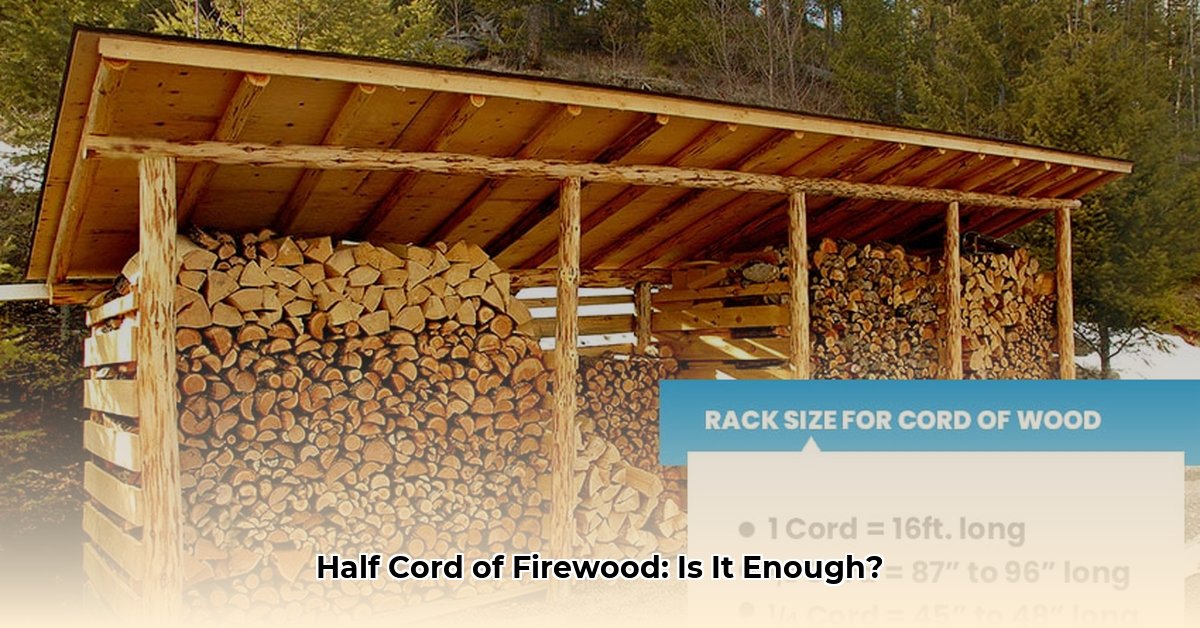Winter’s chill is just around the corner, and for many, that means the cozy crackle of a fireplace. But before you picture yourself nestled by the fire, there’s the practical matter of firewood. This guide is your key to navigating the world of half-cords, ensuring you get a fair deal and a winter’s worth of warmth.
Decoding the Half-Cord Mystery
So, you’re thinking of heating with wood? Smart move! But before you order, let’s demystify the “half-cord.” It’s not just a name; it’s a specific volume of firewood—64 cubic feet, to be exact. This standardization is your protection against being shortchanged. It’s important to note that some research suggests wood volume can vary due to stacking methods, even within the standard half-cord measurement.
Sizing Up a Half-Cord: Dimensions and Volume
Visualizing 64 cubic feet can be tricky. Think of it as a neatly stacked pile, 4 feet high, 4 feet wide, and 4 feet deep. But remember, the dimensions can flex. A 2x4x8-foot stack is also a half-cord. The key is the total volume remains 64 cubic feet. This flexibility is particularly helpful when planning your wood storage.
Does Your Truck Measure Up? Half-Cord Hauling Tips
Before ordering, consider transportation. Can your truck handle 64 cubic feet of firewood? Visualize a half-cord in your truck bed. A standard short-bed pickup (around 6.5 feet) might accommodate a portion, but a long bed (around 8 feet) provides more leeway.
Here’s a general guideline:
| Truck Bed Size | Estimated Half-Cord Capacity |
|---|---|
| Short Bed (6ft) | ⅓ to ½ (likely two trips) |
| Standard Bed (8ft) | ½ to ¾ (probably one trip, maybe two) |
| Long Bed (8+ ft) | ¾ to 1+ (should fit a full half-cord) |
These are estimates. Actual capacity depends on stacking, wood size, and truck bed dimensions. Remember, hardwood weighs significantly more than softwood, and green wood is heavier than seasoned. Don’t overload your truck! Check your owner’s manual for payload capacity. Secure the load with strong straps to prevent shifting during transport. If hauling seems daunting, consider delivery.
What’s the Damage? Unpacking Half-Cord Costs
How much will a half-cord set you back? The typical range is $100-$300, but expect fluctuations based on location, wood type (hardwoods like oak cost more than softwoods like pine), seasoning (seasoned wood commands a premium), and delivery options. Shop around for the best deal.
Some ballpark figures:
| Region | Estimated Price Range |
|---|---|
| Pacific NW | $150-$250 |
| Northeast | $200-$350 |
| Midwest | $180-$300 |
| South | $120-$220 |
These are estimates; actual prices vary. Always get quotes from multiple suppliers.
Stacking and Storing: The Art of Firewood Preservation
Once home, proper stacking and storage are crucial. Elevate the woodpile with pallets, concrete blocks, or gravel for airflow. Stack tightly, crisscrossing for stability, like building a miniature log cabin. Cover the top with a tarp for weather protection, but keep the sides open for air circulation, which aids seasoning.
Seasoned vs. Unseasoned: Fueling the Fire Efficiently
Seasoned wood is like a well-aged wine—it burns hotter, cleaner, and more efficiently than green wood. How can you tell? Seasoned wood has cracks in the ends and emits a dull thud when struck. Burning green wood is smoky, inefficient, and increases creosote buildup in your chimney. Aim for wood with less than 20% moisture content, although achieving this consistently can be a challenge.
Playing by the Rules: Firewood and the Law
In many regions, selling firewood by non-standard units (like “truckload” or “rick”) is illegal. This protects consumers from shady practices. Stick to cords or fractions of a cord.
Sustainable Firewood: Burning Responsibly
Consider the source of your firewood. Supporting sustainable forestry is crucial for environmental health. Ask suppliers about their practices. Certifications like the Forest Stewardship Council (FSC) indicate responsible harvesting. Current research is exploring the long-term effects of different harvesting methods on forest ecosystems.
Finding a Reputable Supplier: Your Firewood Matchmaker
Word-of-mouth is invaluable. Ask neighbors, friends, or your local hardware store for recommendations. Online reviews offer insights into supplier reliability. A good supplier is transparent about measurements, delivery, and wood types.
Firewood FAQs: Addressing Burning Questions
Q: What’s the best wood to burn?
A: Dense hardwoods (oak, maple, hickory) burn longer and hotter, providing sustained heat. Softwoods (pine, fir) ignite easily and are good for kindling, but burn faster. The optimal choice depends on your needs and budget.
Q: How long does seasoning take?
A: Seasoning time ranges from 6-12 months, influenced by wood type, climate, and stacking. Splitting wood speeds drying. Ongoing research suggests methods like solar kilns might accelerate the process, but the long-term effects on wood quality are still being studied.
Q: Cord vs. Face Cord?
A: A cord is 128 cubic feet (4x4x8). A face cord is 4 feet high and 8 feet long, but the depth varies, making it an unreliable measurement. Stick with cords and fractions of cords for a fair deal.
- Greenhouse Storage Shed Combos: Your Guide to Combining Growing and Storage - April 21, 2025
- Greenhouse Shed Combo: Design, Build & Grow Year-Round - April 21, 2025
- Gingham vs. Plaid: What’s the Difference? A Complete Guide - April 21, 2025










